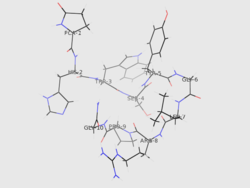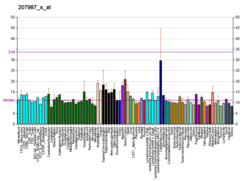Gonadotropin-oslobađajući hormon
Gonadotropin-oslobađajući hormon (GnRH) je hormon koji oslobađaju neuroni u hipotalamusu u sistemu krvnih sudova portalnog sistema u hipofizi. To je dekapeptid koji stimulra prednji režanj hipofize za oslobađanje gonadotropina (luteinizirajući hormon, LH i folikul-stimulirajući hormon, FSH).[5]
Struktura
urediPrekursor ovog hormona sadrži 92 aminokiseline. GnRH sastoji se od 10 aminokiselina: p Glu – His – Trp – Ser – Tyr – Gly – Leu – Arg – Pro – Gly · NH2.[6]
Struktura i genetika GnRH
urediGNRH1 gen, prekursor GnRH, nalazi se na hromosomu 8. Kod sisara se linearni dekapeptid koji je konačni proizvod sintetizira iz prehormona 92 aminokiseline u preoptičkom dijelo prednjeg hipotalamusa
Identitet GnRH otkrili su 1977. Roger Guillemin i Andrew Schally, dobitnici Nobelove nagrade za fiziologiju ili medicinu:[7]
piroGlu –His – Trp –Ser –Tyr – Gly – Leu – Arg –Pro –Gly CONH2;
Funkcija
urediNeuronska soma za izlučivanja GnRH nalaze se uglavnom u medijalnom dijelu prednjeg području preoptičkog dijela hipotalamusa i ispred zglobnog jezgra (infundibulski) i njegovi nervni završeci, raspodijeljeni su u obliku mreže prema srednjem uzvišenju, pored hipofizne drške.[8][9]
Lučenje GnRH, kod svih kičmenjaka je neophosno za normalne spolne funkcije.[10] Dakle, jedan hormon, GnRH1, kontrolira složen proces rasta folikula rasta, ovulacije, održavanje corpus luteum u ženki i spermatogeneze u mužjaka.[11]
Postoje razlike u izlučivanju GnRH između žena i muškaraca. Kod muškaraca GnRH izlučuje se u impulsima konstantnom frekvencijom; međutim, kod žena frekvencija pulsa varira tokom menstrualnog ciklusa, a javlja se i velik porast GnRH neposredno prije ovulacije[9]
GnRH se oslobađa na pulsilrajući, to jest naizmjenično, s razdobljima izlučivanja s razdobljima u kojima se hormon ne luči, iako se u preovulatornom periodu pojavljuje prividno kontinuirana razina proizvodnje.
Pulsativnoi obrazac izlučivanja GnRH ključan je u regulaciji ženskog spolnog ciklusa. Brzina pulsiranja luteinirajućeg hormona, koja vjerovatno odražava brzinu pulsa GnRH, u lutealnoj fazi je niska i maksimalno se povećava u folikulskoj i preovulacijskoj fazi
Razinu sekrecije hormona koji oslobađa gonadotropin (GnRH) regulira kispeptin proizveden u kispeptinskim neuronima, koji su zauzvrat regulirani nivoom spolnih steroida.
Medicinska upotreba
urediGnRH je dostupan u obliku gonadorelin-hidrohlorida (Factrel) za injekcijsku upotrebu. Koristi se putem sistema za perfuzijsku pumpu za indukciju ovulacije kod pacijenata sa hipotalamusnim hipogonadizmom.
Analog GnRH, leuprolid, koristi se kontinuiranom infuzijom za liječenje karcinoma dojke, endometrioze, karcinoma prostate i prijevremenog puberteta.[12]
Također pogledajte
urediReference
uredi- ^ a b c GRCh38: Ensembl release 89: ENSG00000147437 - Ensembl, maj 2017
- ^ a b c GRCm38: Ensembl release 89: ENSMUSG00000015812 - Ensembl, maj 2017
- ^ "Human PubMed Reference:". National Center for Biotechnology Information, U.S. National Library of Medicine.
- ^ "Mouse PubMed Reference:". National Center for Biotechnology Information, U.S. National Library of Medicine.
- ^ Dong KW, Yu KL, Chen ZG, Chen YD, Roberts JL (juli 1997). "Characterization of multiple promoters directing tissue-specific expression of the human gonadotropin-releasing hormone gene". Endocrinology. 138 (7): 2754–62. doi:10.1210/en.138.7.2754. PMID 9202214.
- ^ Kochman, K. (2012). "Evolution of gonadotropin-releasing hormone (GnRH) structure and its receptor". Journal of Animal and Feed Sciences. 21 (1): 6. Nepoznati parametar
|name-list-format=zanemaren (prijedlog zamjene:|name-list-style=) (pomoć) - ^ "The Nobel Prize in Physiology or Medicine 1977". www.nobelprize.org. Nobel Media AB 2014. Pristupljeno 24. 6. 2016.
- ^ Jayes FC, Britt JH, Esbenshade KL (april 1997). "Role of gonadotropin-releasing hormone pulse frequency in differential regulation of gonadotropins in the gilt" (PDF). Biology of Reproduction. 56 (4): 1012–9. doi:10.1095/biolreprod56.4.1012. PMID 9096885. Arhivirano s originala (PDF), 23. 9. 2015.
- ^ a b Ehlers K, Halvorson L (2013). "Gonadotropin-releasing Hormone (GnRH) and the GnRH Receptor (GnRHR)". The Global Library of Women's Medicine. doi:10.3843/GLOWM.10285. Pristupljeno 5. 11. 2014.
- ^ Tsutsumi R, Webster NJ (17. 7. 2009). "GnRH pulsatility, the pituitary response and reproductive dysfunction". Endocrine Journal. 56 (6): 729–37. doi:10.1507/endocrj.K09E-185. PMC 4307809. PMID 19609045.
- ^ Jayes FC, Britt JH, Esbenshade KL (april 1997). "Role of gonadotropin-releasing hormone pulse frequency in differential regulation of gonadotropins in the gilt" (PDF). Biology of Reproduction. 56 (4): 1012–9. doi:10.1095/biolreprod56.4.1012. PMID 9096885. Arhivirano s originala (PDF), 23. 9. 2015.
- ^ "Hormona liberadora de gonadotropina (GnRH) - Gonadotropina .com". www.gonadotropina.com. Pristupljeno 21. 12. 2019.
Dopunska literatura
uredi- Flanagan CA, Millar RP, Illing N (maj 1997). "Advances in understanding gonadotrophin-releasing hormone receptor structure and ligand interactions". Reviews of Reproduction. 2 (2): 113–20. doi:10.1530/ror.0.0020113. PMID 9414473.
- Leung PC, Cheng CK, Zhu XM (april 2003). "Multi-factorial role of GnRH-I and GnRH-II in the human ovary". Molecular and Cellular Endocrinology. 202 (1–2): 145–53. doi:10.1016/S0303-7207(03)00076-5. PMID 12770744.
- Gründker C, Emons G (oktobar 2003). "Role of gonadotropin-releasing hormone (GnRH) in ovarian cancer". Reproductive Biology and Endocrinology. 1: 65. doi:10.1186/1477-7827-1-65. PMC 239893. PMID 14594454.
- Limonta P, Moretti RM, Montagnani Marelli M, Motta M (decembar 2003). "The biology of gonadotropin hormone-releasing hormone: role in the control of tumor growth and progression in humans". Frontiers in Neuroendocrinology. 24 (4): 279–95. doi:10.1016/j.yfrne.2003.10.003. PMID 14726258.
- Janáky T, Juhász A, Bajusz S, Csernus V, Srkalovic G, Bokser L, Milovanovic S, Redding TW, Rékási Z, Nagy A (februar 1992). "Analogues of luteinizing hormone-releasing hormone containing cytotoxic groups". Proceedings of the National Academy of Sciences of the United States of America. 89 (3): 972–6. doi:10.1073/pnas.89.3.972. PMC 48367. PMID 1310542.
- Healey SC, Martin NG, Chenevix-Trench G (novembar 1991). "NcoI RFLP of the human LHRH gene on chromosome 8p". Nucleic Acids Research. 19 (21): 6059. doi:10.1093/nar/19.21.6059. PMC 329079. PMID 1682898.
- Williamson P, Lang J, Boyd Y (novembar 1991). "The gonadotropin-releasing hormone (Gnrh) gene maps to mouse chromosome 14 and identifies a homologous region on human chromosome 8". Somatic Cell and Molecular Genetics. 17 (6): 609–15. doi:10.1007/BF01233626. PMID 1767338.
- Hayflick JS, Adelman JP, Seeburg PH (august 1989). "The complete nucleotide sequence of the human gonadotropin-releasing hormone gene". Nucleic Acids Research. 17 (15): 6403–4. doi:10.1093/nar/17.15.6403. PMC 318303. PMID 2671939.
- Nikolics K, Mason AJ, Szönyi E, Ramachandran J, Seeburg PH (1985). "A prolactin-inhibiting factor within the precursor for human gonadotropin-releasing hormone". Nature. 316 (6028): 511–7. doi:10.1038/316511a0. PMID 2863757.
- Adelman JP, Mason AJ, Hayflick JS, Seeburg PH (januar 1986). "Isolation of the gene and hypothalamic cDNA for the common precursor of gonadotropin-releasing hormone and prolactin release-inhibiting factor in human and rat". Proceedings of the National Academy of Sciences of the United States of America. 83 (1): 179–83. doi:10.1073/pnas.83.1.179. PMC 322815. PMID 2867548.
- Yang-Feng TL, Seeburg PH, Francke U (januar 1986). "Human luteinizing hormone-releasing hormone gene (LHRH) is located on short arm of chromosome 8 (region 8p11.2----p21)". Somatic Cell and Molecular Genetics. 12 (1): 95–100. doi:10.1007/BF01560732. PMID 3511544.
- Seeburg PH, Adelman JP (1984). "Characterization of cDNA for precursor of human luteinizing hormone releasing hormone". Nature. 311 (5987): 666–8. doi:10.1038/311666a0. PMID 6090951.
- Tan L, Rousseau P (decembar 1982). "The chemical identity of the immunoreactive LHRH-like peptide biosynthesized in the human placenta". Biochemical and Biophysical Research Communications. 109 (3): 1061–71. doi:10.1016/0006-291X(82)92047-2. PMID 6760865.
- Dong KW, Yu KL, Roberts JL (decembar 1993). "Identification of a major up-stream transcription start site for the human progonadotropin-releasing hormone gene used in reproductive tissues and cell lines". Molecular Endocrinology. 7 (12): 1654–66. doi:10.1210/me.7.12.1654. PMID 8145771.
- Kakar SS, Jennes L (novembar 1995). "Expression of gonadotropin-releasing hormone and gonadotropin-releasing hormone receptor mRNAs in various non-reproductive human tissues". Cancer Letters. 98 (1): 57–62. doi:10.1016/S0304-3835(06)80010-8. PMID 8529206.
- Nagy A, Schally AV, Armatis P, Szepeshazi K, Halmos G, Kovacs M, Zarandi M, Groot K, Miyazaki M, Jungwirth A, Horvath J (juli 1996). "Cytotoxic analogs of luteinizing hormone-releasing hormone containing doxorubicin or 2-pyrrolinodoxorubicin, a derivative 500-1000 times more potent". Proceedings of the National Academy of Sciences of the United States of America. 93 (14): 7269–73. doi:10.1073/pnas.93.14.7269. PMC 38972. PMID 8692981.
- Chegini N, Rong H, Dou Q, Kipersztok S, Williams RS (septembar 1996). "Gonadotropin-releasing hormone (GnRH) and GnRH receptor gene expression in human myometrium and leiomyomata and the direct action of GnRH analogs on myometrial smooth muscle cells and interaction with ovarian steroids in vitro". The Journal of Clinical Endocrinology and Metabolism. 81 (9): 3215–21. doi:10.1210/jc.81.9.3215. PMID 8784072.
- Bonaldo MF, Lennon G, Soares MB (septembar 1996). "Normalization and subtraction: two approaches to facilitate gene discovery". Genome Research. 6 (9): 791–806. doi:10.1101/gr.6.9.791. PMID 8889548.
- Twan WH, Hwang JS, Lee YH, Jeng SR, Yueh WS, Tung YH, Wu HF, Dufour S, Chang CF (januar 2006). "The presence and ancestral role of gonadotropin-releasing hormone in the reproduction of scleractinian coral, Euphyllia ancora". Endocrinology. 147 (1): 397–406. doi:10.1210/en.2005-0584. PMID 16195400.





